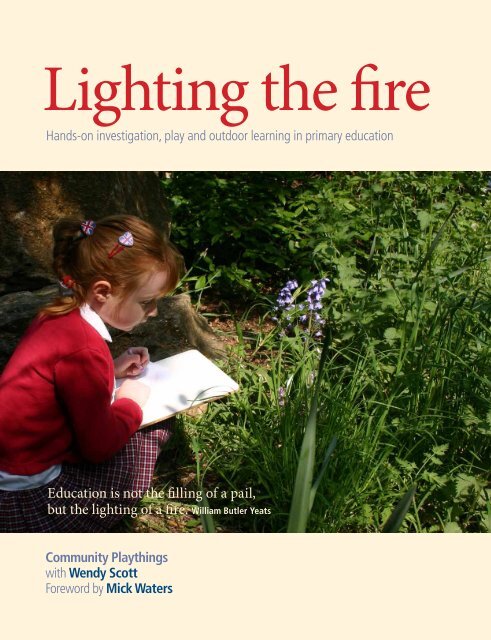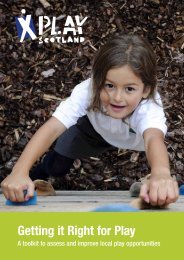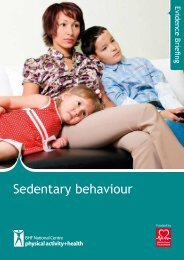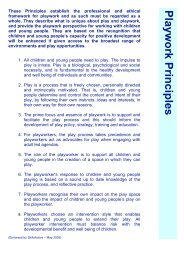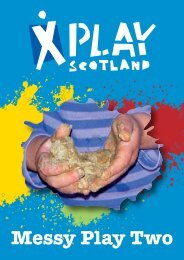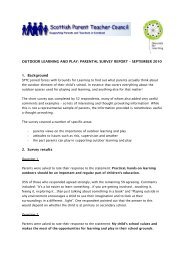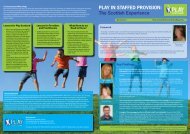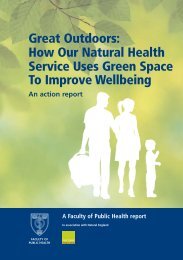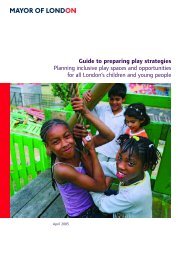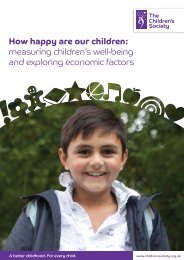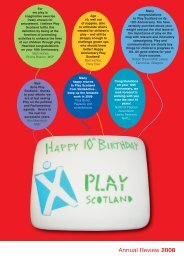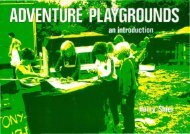Lighting the fire - Play Scotland
Lighting the fire - Play Scotland
Lighting the fire - Play Scotland
Create successful ePaper yourself
Turn your PDF publications into a flip-book with our unique Google optimized e-Paper software.
<strong>Lighting</strong> <strong>the</strong> <strong>fire</strong><br />
Hands-on investigation, play and outdoor learning in primary education<br />
Education is not <strong>the</strong> filling of a pail,<br />
but <strong>the</strong> lighting of a <strong>fire</strong>. William Butler Yeats<br />
Community <strong>Play</strong>things<br />
with Wendy Scott<br />
Foreword by Mick Waters
<strong>Lighting</strong> <strong>the</strong> <strong>fire</strong><br />
Hands-on investigation, play and outdoor learning in primary education<br />
Foreword<br />
I often think that, if I had my time again, I would pretend that I<br />
couldn’t write. Once teachers know that you can, <strong>the</strong>y make you do<br />
more and more of it. The clerical burden takes over and o<strong>the</strong>r<br />
doorways to learning seem to close. Not that <strong>the</strong>re is anything<br />
wrong with writing; it’s just that it has to serve a real purpose.<br />
<strong>Lighting</strong> <strong>the</strong> <strong>fire</strong> stimulates thinking about how best we learn and<br />
particularly how best young children learn. It is well referenced and<br />
researched, revisiting <strong>the</strong> work of Froebel, tapping into evidence<br />
from home and overseas, and highlighting case study examples that<br />
bring <strong>the</strong>ory to life.<br />
The three domains considered: play, using <strong>the</strong> outdoors and<br />
exploring first-hand experience are justified through <strong>the</strong>ir impact<br />
upon wider learning (<strong>the</strong> sort that <strong>the</strong> clerical, formal world tries to<br />
achieve) and <strong>the</strong>ir impact upon <strong>the</strong> child as a person. It looks at<br />
purpose in experience and how rigour in all aspects takes<br />
development forward.<br />
Enjoy <strong>the</strong> pamphlet and play with <strong>the</strong> ideas, take yourself into <strong>the</strong><br />
child’s mindset and explore possibilities. It is called <strong>Lighting</strong> <strong>the</strong> <strong>fire</strong>;<br />
it will ignite your thinking. For <strong>the</strong> children’s sake, it is worth it.<br />
Mick Waters<br />
Professor of Education and President of <strong>the</strong> Curriculum Foundation<br />
1
Kindling interest<br />
The question is not ‘Are <strong>the</strong> children ready for school?’ but ‘Is <strong>the</strong> school ready for<br />
children?’ Wendy Scott<br />
The current emphasis on test scores and league<br />
tables induces many schools to rely on formal<br />
teaching methods. But is this how children really<br />
learn? The Guardian reported on <strong>the</strong> Cambridge<br />
Review of Primary Education (2009):<br />
‘More than 70 academics have produced 29 reports<br />
with thousands of children, parents, teachers and<br />
head teachers taking part in surveys across <strong>the</strong><br />
country. It presents a damning view of <strong>the</strong> primary<br />
curriculum, which it suggests has failed generations<br />
of children... There is an over-emphasis on <strong>the</strong> skills<br />
of reading, writing and maths at <strong>the</strong> expense of<br />
o<strong>the</strong>r subjects, <strong>the</strong> report claims. This limits<br />
children’s enjoyment of school and risks severely<br />
compromising <strong>the</strong>ir natural curiosity, imagination<br />
and love of learning.’ (20 February 2009)<br />
This is a wake-up call. The review reminds us that<br />
‘Childhood is a valuable time in its own right. It is a<br />
time to be relished...’ (Hofkins and Nor<strong>the</strong>n, 2009)<br />
Teachers who are awed by <strong>the</strong> depth and complexity<br />
of what children already know, nurture and extend<br />
that learning as opportunities arise. They<br />
understand children’s physiological need to move.<br />
They value <strong>the</strong> whole child – heart, head and hand.<br />
England has an excellent internationally recognised<br />
early years tradition in its maintained Nursery<br />
Schools, where children’s independence and delight<br />
in discovery are fostered. Fortunately some primary<br />
schools have chosen to build on that foundation,<br />
carrying this happy confidence forward in children’s<br />
daily experience. The first Nursery School was<br />
founded in 1914 by Margaret McMillan, who was<br />
strongly influenced by Friedrich Froebel.<br />
2<br />
We had a student some years ago who<br />
struggled hard with <strong>the</strong> challenges of<br />
dyslexia. Remedial help only alienated him<br />
until he had a new SEN teacher with a<br />
different approach: she brought an incubator<br />
and some goose eggs. Nine-year-old Jed was<br />
fascinated. He monitored temperature and<br />
humidity and designed charts to document<br />
<strong>the</strong>m. He asked questions and signed out<br />
books from <strong>the</strong> library, something he had<br />
never done. When <strong>the</strong> goslings hatched he<br />
cared for <strong>the</strong>m, and <strong>the</strong> project expanded to<br />
include o<strong>the</strong>r creatures. Now a young man,<br />
Jed has found fulfilling work caring for<br />
people with disabilities.<br />
Head teacher, East Sussex
Froebel (1782–1852) is known as fa<strong>the</strong>r of <strong>the</strong><br />
kindergarten, but his progressive school went<br />
through <strong>the</strong> primary years. His belief that teachers<br />
should help children make <strong>the</strong>ir own discoveries<br />
was revolutionary at a time when pupils were<br />
expected to sit still and obey orders in school;<br />
discipline and rote memorisation had been <strong>the</strong> goal.<br />
Froebel said, ‘To awaken <strong>the</strong> pleasure and power of<br />
<strong>the</strong> human being to effect his own education has<br />
always been <strong>the</strong> aim of my work’ and ‘The purpose<br />
of teaching is to bring out of children ra<strong>the</strong>r than to<br />
put more and more into <strong>the</strong>m... To have discovered<br />
a quarter of <strong>the</strong> answer to his question by his own<br />
effort is of more value to <strong>the</strong> child than to hear it all,<br />
half-understood, from ano<strong>the</strong>r.’<br />
Froebel believed curiosity to be children’s leading<br />
intellectual asset; he <strong>the</strong>refore recommended that<br />
<strong>the</strong>y invent problems, as this allows for more<br />
originality and leads to better comprehension than<br />
just solving problems. Froebel protested against any<br />
‘stamping and moulding’ system that failed to<br />
acknowledge children’s individuality. And he<br />
pointed out that mere listening leaves children in a<br />
passive state – sustained interest requires some form<br />
of action on <strong>the</strong>ir part. (Hughes, 1897) Many<br />
current educators agree.<br />
When I was in Year 4,<br />
I had a really creative<br />
teacher. Mrs Jory’s<br />
classroom was a<br />
paradise of<br />
terrariums,<br />
aquariums, gadgets<br />
of all kinds, clocks<br />
where you could<br />
move <strong>the</strong> hands,<br />
meccano sets... I<br />
loved it so much I<br />
played truant from<br />
break to experiment<br />
with all this stuff!<br />
Former student,<br />
Shropshire<br />
3
‘Imagination does not only develop from what<br />
children see but also from <strong>the</strong> wide range of<br />
ways in which ideas can be represented. Singing<br />
and dancing, rhythm and rhyme, humour and<br />
narrative all have a role to play in developing<br />
imaginative thinking... All too often, <strong>the</strong> poetic<br />
connections and imaginative comparisons<br />
which children make are seen as frills, to be set<br />
aside in order to get on with teaching what are<br />
called basic skills. In reality, <strong>the</strong>se forms of<br />
thinking and imagining are <strong>the</strong> real foundations<br />
of learning.’ Pound, 2009<br />
Froebel realised that children are tremendously<br />
motivated for any task that is <strong>the</strong>ir own idea. He<br />
believed self-expression to be <strong>the</strong> most effective way<br />
of training children’s cognitive abilities, and his goal<br />
was for students to become ‘independent, thinking<br />
individuals.’ The teacher’s main task was to<br />
streng<strong>the</strong>n <strong>the</strong> power of choice and enjoyment of<br />
work, which are ultimately more important than a<br />
memory stored with facts.<br />
Education must come alive! If interest is kindled,<br />
children take initiative and make <strong>the</strong> knowledge<br />
<strong>the</strong>ir own.<br />
4
<strong>Play</strong><br />
In play, a child is always above his average age, above his daily behaviour; in play,<br />
it is as though he were a head taller than himself. Lev Vygotsky<br />
One way children ‘make knowledge <strong>the</strong>ir own’ is<br />
through play. ‘Children are at <strong>the</strong> height of <strong>the</strong>ir<br />
powers when <strong>the</strong>y are playing’. (Scott, 2008) In play<br />
a child expends energy voluntarily and develops<br />
physically, intellectually and emotionally. <strong>Play</strong><br />
builds key communication and social skills such as<br />
negotiating, discussing plans and sharing resources.<br />
<strong>Play</strong>work is a discipline that began in <strong>the</strong> UK and is<br />
expanding abroad. Its first principles state:<br />
‘All children and young people need to play. The<br />
impulse to play is innate. <strong>Play</strong> is a biological,<br />
psychological and social necessity, and is<br />
fundamental to <strong>the</strong> healthy development and<br />
well-being of individuals and communities.<br />
‘<strong>Play</strong> is a process that is freely chosen, personally<br />
directed and intrinsically motivated. That is,<br />
children and young people determine and<br />
control <strong>the</strong> content and intent of <strong>the</strong>ir play by<br />
following <strong>the</strong>ir own instincts, ideas and<br />
interests, in <strong>the</strong>ir own way, for <strong>the</strong>ir own<br />
reasons.’ <strong>Play</strong>work Principles, quoted in<br />
Wilson, 2010.<br />
5
Until <strong>the</strong> advent of screen activities, school-age<br />
children organised lively games of <strong>the</strong>ir own from<br />
hopscotch, marbles, conkers and skipping in <strong>the</strong><br />
street, to cops and robbers in <strong>the</strong> playground or<br />
hide-and-seek, tree-climbing and den-building in<br />
<strong>the</strong> woods. Over <strong>the</strong> past decades <strong>the</strong>re has been a<br />
surge in television and electronic games. Virtual<br />
play is removing youngsters from real play; many<br />
are being moulded into an unnaturally sedentary<br />
lifestyle and becoming dependent on technological<br />
gimmicks. Boredom and obesity are problems.<br />
Actually <strong>the</strong> simplest materials facilitate <strong>the</strong> richest<br />
play because <strong>the</strong>y fuel imagination – most adults<br />
can recall a wealth of childhood experience playing<br />
with whatever was at hand.<br />
6
‘For children, play can be (and often is) a very<br />
serious business. It needs concentrated<br />
attention. It is about children learning through<br />
perseverance, attention to detail, and<br />
concentration – characteristics usually<br />
associated with work. <strong>Play</strong> is not only crucial to<br />
<strong>the</strong> way children become self-aware and <strong>the</strong> way<br />
in which <strong>the</strong>y learn <strong>the</strong> rules of social<br />
behaviour; it is also fundamental to intellectual<br />
development.’ Welsh Foundation Phase<br />
Framework for Children’s Learning, 2008<br />
<strong>Play</strong> is not just for after school but should be<br />
incorporated in <strong>the</strong> school day. At <strong>the</strong> <strong>Play</strong> Research<br />
Seminar at Leeds University in April 2008, Dr<br />
Justine Howard of Swansea University reported that<br />
when children practice a task playfully, <strong>the</strong>y show<br />
superior problem-solving skills and higher levels of<br />
motivation and are more deeply engaged than<br />
children who practice <strong>the</strong> same task in a more<br />
formal manner. (Howard, Thomas & Miles, 2006;<br />
McInnes, Howard, Miles and Crowley, 2009;<br />
Howard, 2010)<br />
‘There is no evidence that a child who spends<br />
more time learning through lessons – as<br />
opposed to learning through play – will “do<br />
better” in <strong>the</strong> long run. In fact, research suggests<br />
<strong>the</strong> opposite; that too formal too soon can be<br />
dangerously counterproductive. In 14 of <strong>the</strong> 15<br />
countries that scored higher than England in a<br />
major study of reading and literacy in 2006,<br />
children did not enter school until <strong>the</strong>y were six<br />
or seven. And more children read for pleasure in<br />
most of those countries than do so in England.’<br />
Hofkins and Nor<strong>the</strong>n, 2009<br />
7
Describing <strong>the</strong> three-year Oxfordshire Transition<br />
Project, Julie Fisher (2010) writes, ‘Where high<br />
quality play has become a central process for<br />
learning in Key Stage 1, standards in many aspects<br />
of <strong>the</strong> curriculum have been raised. Having more<br />
opportunities to initiate <strong>the</strong>ir own learning gives<br />
children a greater stake in <strong>the</strong>ir education... Almost<br />
every teacher participating in <strong>the</strong> Project who<br />
introduced play as a major element of <strong>the</strong> learning<br />
day said that standards in writing had improved<br />
– especially for reluctant writers.’ She argues that ‘In<br />
play, no one gives boundaries to <strong>the</strong> learning, so<br />
children explore at <strong>the</strong> very edges of <strong>the</strong>ir own<br />
experience, reasoning and imagination.’<br />
Presenting <strong>the</strong> findings of <strong>the</strong> TACTYC play<br />
colloquium in <strong>the</strong> House of Commons in 2008,<br />
Professor Pat Broadhead said, ‘Because <strong>the</strong> future is<br />
unpredictable, we must educate children to be<br />
adaptable and independent. There is evidence that<br />
play provides better for flexible and creative<br />
thinking and learning than closely prescribed<br />
teaching and testing.’ (Introduction in Wood et al,<br />
2010) Of course this way of working does not<br />
remove <strong>the</strong> need for adult-led learning; what we are<br />
striving for is a balance. Suggestions for how to<br />
strike this balance can be found in chapter four of<br />
Julie Fisher’s book. (See references on page 24.)<br />
Whilst playing, children experiment with words,<br />
developing language patterns and voicing ideas.<br />
Through listening, observant teachers gain windows<br />
into children’s logic, wisdom and whimsical<br />
wonderings.<br />
Debra, age 6<br />
“I wonder how <strong>the</strong> Gingerbread<br />
Boy felt when he was raw...”<br />
Young children instinctively re-enact events <strong>the</strong>y<br />
experience or witness, thus consolidating <strong>the</strong>ir<br />
understanding. Such re-enactment takes place<br />
through small-world play with miniature figures<br />
and in role play in which <strong>the</strong> children <strong>the</strong>mselves<br />
are <strong>the</strong> actors. When space and time are allowed for<br />
this in Key Stage 1 classrooms, <strong>the</strong> transition from<br />
Foundation Stage is eased.<br />
Alfie, age 5<br />
“You can be my extinguished guest.<br />
Or do you have ano<strong>the</strong>r invitement?”<br />
8
Blockplay deserves a designated area of <strong>the</strong><br />
classroom because Key Stage 1 children who might<br />
have difficulty in writing may show remarkable fine<br />
motor control with blocks – and of course ‘Children<br />
who feel empowered are more likely to be better<br />
and happier learners’. (Hofkins and Nor<strong>the</strong>n, ibid)<br />
The blockplay area must be protected from traffic<br />
and have sufficient floor space for several projects to<br />
be under construction. Blockplay gives children<br />
hands-on experience in maths and physics: mass,<br />
length, width, shape, balance, symmetry, structure,<br />
design, proportion, counting, adding, subtracting…<br />
Even before children learn terminology, <strong>the</strong>y<br />
internalise concepts. They may not have learned<br />
about fractions, for example, but <strong>the</strong>y notice that<br />
one block is a quarter or half <strong>the</strong> size of ano<strong>the</strong>r.<br />
(Gura, 1992)<br />
Educators are realising blockplay’s connection with<br />
reading and writing. Not only do children develop<br />
fine motor skills and hand-eye coordination, but <strong>the</strong><br />
confidence established as children communicate<br />
ideas with blocks builds a foundation for fur<strong>the</strong>r forms<br />
of self-expression, such as written language. Children<br />
frequently tell elaborate narratives while <strong>the</strong>y create<br />
with blocks, often based on experiences <strong>the</strong>y have had<br />
or stories <strong>the</strong>y’ve been told. (Marin, 2004)<br />
Jack, age 6<br />
“Gravity is invisible but if<br />
it weren’t it would be green!”<br />
Blockplay and small-world play are a natural<br />
combination in many classrooms. Shelves with<br />
wheels are helpful because <strong>the</strong> space can be easily<br />
altered to highlight different activities. And if <strong>the</strong>se<br />
storage shelves have attractive backs, <strong>the</strong>y can serve<br />
as room dividers and display surfaces as well.<br />
9
The large hollow blocks are also a favourite in Key<br />
Stage 1 and 2. Using <strong>the</strong>m, children combine<br />
construction with role play, and creative fun can be<br />
observed across differences in age and gender.<br />
Albert Einstein once said, ‘Imagination is more<br />
important than knowledge’; to become innovative<br />
thinkers, children need to immerse in imaginative<br />
play like this.<br />
‘When Year 1 teachers are reinstating openended<br />
play in various ways, we see almost a<br />
regression at first as if children have to get used<br />
to it all over again. They tend to play as a<br />
younger child might; but as time passes and<br />
<strong>the</strong>y realise play is a permanent fixture, <strong>the</strong>y<br />
create and settle into increasingly complex play<br />
scenarios. The developed language and wider<br />
experience of <strong>the</strong> world come to <strong>the</strong> fore.<br />
Language becomes incredibly rich and a really<br />
important part of problem setting and solving.’<br />
Pat Broadhead, 2010<br />
<strong>Play</strong> has tremendous healing power. Society today<br />
bombards children with advertising, technology<br />
and adult pressures and <strong>the</strong>n deprives <strong>the</strong>m of <strong>the</strong><br />
very play that would help <strong>the</strong>m cope. Children’s<br />
urge to play is like a spring of water; in some it has<br />
been obstructed by issues <strong>the</strong>y are dealing with, but<br />
<strong>the</strong> spring is still within every child, waiting for<br />
release. (Almon, 2011)<br />
10
Hands-on<br />
investigation<br />
I am nei<strong>the</strong>r very clever nor especially gifted. I am only very, very curious! Einstein<br />
‘In 2006, we extended <strong>the</strong> foundation stage<br />
principles and practice through to Year 1, and<br />
now to Year 2 as well. We really value its<br />
experiential, investigative and hands-on<br />
learning which suits boys as well girls. It cost us<br />
quite a lot. We had to change <strong>the</strong> furniture, buy<br />
new equipment and retrain <strong>the</strong> staff because we<br />
were changing <strong>the</strong>ir practice completely. But it<br />
worked fantastically. The children are happier<br />
and standards have gone up, particularly for<br />
boys...’ Lynn Wilson, Head teacher of Northfield<br />
Infants School, Hofkins and Nor<strong>the</strong>n, ibid<br />
To a high degree all humans ‘think with our hands’. No<br />
wonder children are instinctively drawn to hands-on<br />
activity. Teachers who are willing to stray from<br />
textbooks to teach maths through cookery, for<br />
example, will be rewarded by children’s enthusiasm.<br />
School subjects become meaningful when lively<br />
interest is sparked.<br />
11
12<br />
My Year 5 class has been learning <strong>the</strong><br />
history and geography of <strong>the</strong> Weald. They<br />
were excited about <strong>the</strong> Long Man of<br />
Wilmington: Why can’t we do something<br />
like that? Maybe we can! What shape could<br />
we make? How? We got permission from <strong>the</strong><br />
farmer to use a field we see from our<br />
window and set to work. Of all our ideas<br />
– after much discussion – we chose a<br />
symmetrical pattern. The project turned<br />
into art and maths too as we had to lay out a<br />
grid first on <strong>the</strong> chalkboard and <strong>the</strong>n on <strong>the</strong><br />
field to map our design. We all learned a<br />
great deal and had terrific fun creating <strong>the</strong><br />
Long Butterfly of Sussex!<br />
Teacher, East Sussex
Year 6 just did a unit on Asia. As <strong>the</strong>re are some Asian students in my class, we invited parents to<br />
share stories, art and songs. The kids got really charged, and results far exceeded my expectation:<br />
with parents’ help, we prepared a cultural evening for all <strong>the</strong> families, including food, drama,<br />
singing and dance. None of us will ever forget it! Teacher, London<br />
Arthur, age 6<br />
“Does salt kill sugar?”<br />
Communication skills grow tremendously through<br />
real-life investigation. Priscilla Vail writes, ‘Schoolage<br />
children do not learn vocabulary by studying<br />
lists, looking up definitions, and writing sentences.<br />
They do learn those new words which “hover at <strong>the</strong><br />
rim of experience.” As we lead students into new<br />
realms and concepts, we can help <strong>the</strong>m grasp <strong>the</strong><br />
vocabulary which matches <strong>the</strong>ir explorations and<br />
new powers.’ (Vail, 1996)<br />
Froebel asserts, ‘We must affirm a child’s powers of<br />
expression by which he proves himself a creative<br />
being, part of <strong>the</strong> whole circle of life;’ (1887) and<br />
Loris Malaguzzi, former director of <strong>the</strong> Reggio<br />
Emilia schools, said that children are not<br />
‘excessively attached to <strong>the</strong>ir own ideas, which <strong>the</strong>y<br />
construct and reinvent continuously. They are apt to<br />
explore, make discoveries, change <strong>the</strong>ir points of<br />
view…Creativity should not be considered a separate<br />
mental faculty but a characteristic of our way of<br />
thinking, knowing, and making choices.’ (Edwards et<br />
al, 1998) Like playfulness, creativity is part of a child’s<br />
approach to life.<br />
13
Art supplies – including natural and recycled items<br />
– should be presented as a smorgasbord to whet<br />
creative appetites. Simpson and Alderson (1950) wrote<br />
that ‘<strong>the</strong> medium itself should be <strong>the</strong> teacher’ and<br />
describe instances in which a child’s ability was<br />
stimulated by materials provided. They describe<br />
children modelling with cast-off bits like wood, corks<br />
or cardboard tubes, and state ‘Clay is a very satisfying<br />
material to handle and to experiment with... we have<br />
dug up our clay from adjoining fields’ – a reminder<br />
that some supplies need not be expensive. Openended<br />
materials like <strong>the</strong>se allow children’s<br />
imaginations to guide <strong>the</strong>ir projects, providing<br />
practice in decision-making.<br />
A child experiencing difficulties at home may find<br />
peace and satisfaction in making things. Some schools<br />
start <strong>the</strong> day with a creative period, giving <strong>the</strong> children<br />
freedom to experiment in <strong>the</strong>ir own ways, to work<br />
through any anxieties before settling into formal tasks.<br />
(Simpson and Alderson, and Fisher, ibid)<br />
The art area must include space to display children’s<br />
work; revisiting <strong>the</strong>ir creations often inspires fur<strong>the</strong>r<br />
involvement. For young children, <strong>the</strong> process is more<br />
important than <strong>the</strong> outcome. As <strong>the</strong>y mature, <strong>the</strong>y<br />
become increasingly interested in perfecting<br />
techniques and taking pride in <strong>the</strong> result of <strong>the</strong>ir<br />
efforts.<br />
Schools can support <strong>the</strong> creative urge by offering<br />
activities like drawing, painting and woodwork. As<br />
<strong>the</strong>y grow, children may branch into fur<strong>the</strong>r<br />
handcrafts – weaving, pottery, metal work, sewing or<br />
calligraphy for example – which not only provide<br />
constructive hobbies but may even determine future<br />
careers. Some who enjoyed woodwork have gone on to<br />
become joiners.<br />
Even beyond <strong>the</strong>ir personal futures, through creative<br />
innovation children develop divergent ways of<br />
thinking essential for humanity’s future. If children are<br />
not familiar with <strong>the</strong> satisfaction of ‘messing about’<br />
and trying new approaches, <strong>the</strong>y may feel insecure in<br />
new situations, fearful of making mistakes, and never<br />
discover <strong>the</strong>ir full potential or learn to think outside<br />
<strong>the</strong> box. ‘Our task, regarding creativity, is to help<br />
children climb <strong>the</strong>ir own mountains, as high as<br />
possible.’ (Edwards et al, ibid)<br />
14
Of course, creativity is broader than art and crafts.<br />
Boys particularly like to deconstruct and are intrigued<br />
by pulleys, ratchets, conveyor belts and o<strong>the</strong>r gadgets,<br />
which explains why David Macauley’s book The Way<br />
Things Work (1988) remains a classic. Some become<br />
amazingly adept – one 12-year-old re-assembled a<br />
clock – and many know more about engines than <strong>the</strong>ir<br />
teachers simply because curiosity drives <strong>the</strong>m to learn.<br />
Ask <strong>the</strong> best mechanics what <strong>the</strong>y enjoyed in<br />
childhood!<br />
Tracy, age 9<br />
“If someone splits wood all day,<br />
chances are he’ll split an atom.”<br />
‘High-tech industries such as NASA’s Jet<br />
Propulsion Laboratory have found that <strong>the</strong>ir<br />
best overall problem solvers were master<br />
tinkerers in <strong>the</strong>ir youth. They have even altered<br />
<strong>the</strong>ir hiring policy to give high priority to this<br />
play background information.’ Brown, 2009<br />
There is an enormous difference between <strong>the</strong> question<br />
‘how does it work?’ (as when children take things apart<br />
or experiment with water flow, gears, levers, etc) and<br />
<strong>the</strong> question ‘how do I make it perform?’ as with most<br />
ICT applications. It is easy to document when a child<br />
achieves ‘how do I make it perform?’ by clicking and<br />
dragging a mouse for example. But <strong>the</strong> ‘how does it<br />
work?’ query generates far deeper understanding.<br />
15
Technology for children should help <strong>the</strong>m understand<br />
mechanical properties and forces, whe<strong>the</strong>r simple<br />
– using a saw to cut wood – or complex. Using a cider<br />
press, children experience how <strong>the</strong>ir physical effort<br />
turning <strong>the</strong> crank rotates <strong>the</strong> shaft that chops <strong>the</strong><br />
apples; <strong>the</strong>n when <strong>the</strong>y screw <strong>the</strong> press onto <strong>the</strong><br />
chipped apples, <strong>the</strong>y see <strong>the</strong> juice flow out <strong>the</strong><br />
bottom – a clear progression of cause and effect.<br />
My 18-year-old daughter just completed <strong>the</strong><br />
International Baccalaureate course. She had<br />
never used a computer before but learned<br />
in no time and excelled in all subjects.<br />
Some people seem afraid of <strong>the</strong>ir children<br />
being digitally inferior or something. But let<br />
kids be children as long as possible! Why<br />
should <strong>the</strong>y be bo<strong>the</strong>red at six with what<br />
<strong>the</strong>y need at 16? After all, electronic<br />
technology is only a tool. And childhood is<br />
so much more than preparation for<br />
adulthood. Parent, USA<br />
Through such practical involvement, children gain<br />
knowledge that <strong>the</strong>ir young minds store and<br />
continually build on. This is so much more real than<br />
electronic technology where a child’s actions, such as<br />
touching a whiteboard, may have little logical<br />
connection to <strong>the</strong> result, perhaps colourful swirls<br />
or a human voice.<br />
‘Facts may be acquired swiftly online, and<br />
shallow learning is easy to assess. Deep learning<br />
and a wisdom that lasts for life all come much<br />
more slowly – and I have yet to access <strong>the</strong><br />
computer programme where <strong>the</strong>y lie.’<br />
Despontin, 2006<br />
Why do many computer company executives send<br />
<strong>the</strong>ir children to computer-free schools? They want<br />
<strong>the</strong>ir sons and daughters to become imaginative<br />
thinkers, appreciating that young people master<br />
new skills – including computer skills – quickly if<br />
<strong>the</strong>y have <strong>the</strong> foundation of confidence established<br />
through a childhood rich in direct experience and<br />
creative reasoning. (Alliance for Childhood, 2000)<br />
16
Outdoor learning<br />
At heart, all learning is about going from what is known and familiar to what is<br />
unknown and uncertain. So learning, growth and development depend upon risk.<br />
Outdoor environments offer <strong>the</strong> best opportunities for children to get to grips with<br />
<strong>the</strong> unpredictable, engaging, challenging world around <strong>the</strong>m. Tim Gill<br />
Outdoor activity helps children keep a positive outlook.<br />
There is no aspect of <strong>the</strong> national curriculum that<br />
cannot be taught outdoors at <strong>the</strong> Key Stage 1 level.<br />
(Dora Plant, Ashbrow Infant School) This approach is<br />
shared by Coombes Primary School where <strong>the</strong>y state,<br />
‘We continue to develop our outdoor environment as<br />
our largest classroom.’<br />
Froebel maintained that <strong>the</strong> capacity to struggle<br />
persistently lies at <strong>the</strong> foundation of character; children<br />
love to encounter challenge in play and work. Outdoor<br />
involvement provides such challenge.<br />
Maureen, age 6<br />
“There’s more apples on this<br />
tree than years in a day!”<br />
17
Some of our Year 1s were already ‘turned off ’ of school. They found it terribly taxing to sit at tables<br />
and hold a pencil just so and write rows of numbers. Then <strong>the</strong> teachers went on a course; when<br />
<strong>the</strong>y returned <strong>the</strong>y took <strong>the</strong> learning outdoors. Now <strong>the</strong>se children are doing maths with fir cones<br />
instead of worksheets, and <strong>the</strong> joy has come back into <strong>the</strong>ir eyes. In fact <strong>the</strong>y spend most of <strong>the</strong> day<br />
outdoors. I was initially worried that parents might be upset by mud on children’s uniforms, but in<br />
fact <strong>the</strong> parents are happy because <strong>the</strong>ir children are happy. Head teacher, Kent<br />
18 – <strong>Lighting</strong> <strong>the</strong> <strong>fire</strong>
Children develop <strong>the</strong>ir vestibular sense (balance)<br />
through teetering, tipping, spinning, swinging,<br />
rocking, jumping, bouncing, sliding and fast<br />
forward motion. They have a biological drive for<br />
such experiences and use any opportunity to run,<br />
slide down banisters, roll down hills, hop from place<br />
to place... In order to develop perfect coordination<br />
of body and brain, children need action in which<br />
<strong>the</strong>ir muscles encounter resistance: pushing,<br />
pulling, stretching, carrying... They like to hang<br />
from bars, to dig and rake, to feel tension in <strong>the</strong>ir<br />
limbs. Skipping rope, climbing trees, pedalling<br />
bicycles and pushing wheelbarrows are actions that<br />
fill this need and only happen outdoors.<br />
Significantly, movement is actually what allows<br />
children to sit still. (Jan White, 2011)<br />
Heads wishing to create ‘provocative environments’<br />
to support such activity might take inspiration from a<br />
Danish landscape architect who was commissioned<br />
to design playgrounds after World War II. When he<br />
later visited <strong>the</strong>se playgrounds and saw almost no<br />
children, he learned that <strong>the</strong>y preferred bombed<br />
buildings to play in – so he changed his approach and<br />
included areas where children could construct with<br />
loose parts and explore.<br />
19
Our school was set up for boys from across<br />
<strong>the</strong> UK who’ve been expelled from school. We<br />
work intensively with <strong>the</strong>m, largely outdoors.<br />
We have a farm, which is particularly<br />
important for <strong>the</strong>se lads. The shepherd will<br />
ring and let us know when a ewe is about to<br />
give birth. It’s amazing – a child who<br />
physically cannot sit still at a desk will sit on a<br />
hay bale for nearly an hour waiting for that<br />
cataclysmic moment of birth. In situations<br />
where a lamb cannot be cared for by its own<br />
mo<strong>the</strong>r, it is fostered by ano<strong>the</strong>r; this leads to<br />
fur<strong>the</strong>r vital conversations with <strong>the</strong> boys.<br />
Teacher<br />
20
In <strong>the</strong> great outdoors, children observe nature. It is<br />
more valuable for a child to learn directly about<br />
even one small creature than to spend <strong>the</strong> same<br />
amount of time collecting facts via internet about<br />
any number of exotic animals. Remote information<br />
gains meaning through direct personal experience;<br />
children are more likely to care about endangered frogs<br />
in <strong>the</strong> rainforest if <strong>the</strong>y have observed <strong>the</strong> marvel of a<br />
frog’s life cycle near home.<br />
When taken to <strong>the</strong> woods, some children expect to see<br />
lions and tigers, because television has been <strong>the</strong>ir only<br />
reference! So <strong>the</strong> forest school movement is timely.<br />
<strong>Scotland</strong> has led <strong>the</strong> way as have several local authorities<br />
in Wales and England.<br />
At our forest school, ten-year-old Bronwyn noticed movement at her feet and squatted down to<br />
observe a large beetle climbing backward up a miniature mountain of earth with a rabbit dropping<br />
clasped in its claws! She watched in fascination as <strong>the</strong> beetle pulled its load onto itself in a dented<br />
hole at <strong>the</strong> top. Bronwyn learned patience as she watched and was full of questions. I helped her<br />
find Jean-Henri Fabre’s book, which spurred fur<strong>the</strong>r observation of insects for Bronwyn and <strong>the</strong><br />
whole class. Teacher, <strong>Scotland</strong><br />
21
We began our nature reserve several years<br />
ago. On three acres of wasteland outside our<br />
school we planted small islands of birdfriendly<br />
shrubs surrounded by wild grasses<br />
and flowers. Before our eyes, nature’s web of<br />
life started unfolding. Flora and fauna of<br />
numerous species flourished and spread,<br />
came and went. Then this winter we made<br />
friends with <strong>the</strong> birds. First we made a<br />
dummy and dressed him in hat, coat and<br />
gloves, on which we sprinkled birdseed.<br />
Soon birds started coming. Next a child<br />
would put on <strong>the</strong> dummy’s clo<strong>the</strong>s with <strong>the</strong><br />
seed, and birds continued to come. It was<br />
not long before tits and nuthatches were<br />
eating from <strong>the</strong> children’s hands – what a<br />
thrill! Head teacher, Sussex<br />
Connecting children with creation informs <strong>the</strong>m about<br />
<strong>the</strong> world, supports <strong>the</strong>ir emotional well-being and<br />
teaches invaluable lessons for life. Biologist Rachel<br />
Carson wrote:<br />
‘If a child is to keep alive his inborn sense of<br />
wonder… he needs <strong>the</strong> companionship of at<br />
least one adult who can share it, rediscovering<br />
with him <strong>the</strong> joy, excitement and mystery of <strong>the</strong><br />
world we live in.<br />
‘Exploring nature with your child is largely a<br />
matter of becoming receptive to what lies all<br />
around you. It is learning again to use your eyes,<br />
ears, nostrils, and finger tips...<br />
‘The more clearly we can focus our attention on<br />
<strong>the</strong> wonders and realities of <strong>the</strong> universe about<br />
us, <strong>the</strong> less taste we shall have for destruction.<br />
‘Those who contemplate <strong>the</strong> beauty of <strong>the</strong> earth<br />
find reserves of strength that will endure as<br />
long as life lasts. There is symbolic as well as<br />
actual beauty in <strong>the</strong> migration of <strong>the</strong> birds, <strong>the</strong><br />
ebb and flow of <strong>the</strong> tides, <strong>the</strong> folded bud ready<br />
for spring. There is something infinitely healing<br />
in <strong>the</strong> repeated refrains of nature – <strong>the</strong><br />
assurance that dawn comes after night, and<br />
spring after winter.’ Carson, 1956<br />
Even at schools with no access to woodlands,<br />
surprising aspects of nature can be observed in <strong>the</strong><br />
playground if <strong>the</strong>re are areas of bushes, grass and<br />
woodchips or soil. A teacher need not know <strong>the</strong><br />
answer to every question but simply be a<br />
companion in discovery. Children appreciate<br />
someone who helps find answers. And for <strong>the</strong> adult,<br />
it is a privilege to view life through a child’s eyes.<br />
Ruby, age 5<br />
“There are a hundred grains of<br />
sand in this sandpit and God<br />
loves every one of <strong>the</strong>m!”<br />
22
Some sacred<br />
memory preserved<br />
from childhood –<br />
that is perhaps <strong>the</strong><br />
best education.<br />
Fyodor Dostoyevsky<br />
23
References and<br />
resources<br />
Alexander, R.J. (ed) Children, <strong>the</strong>ir<br />
World, <strong>the</strong>ir Education: final report and<br />
recommendations of <strong>the</strong> Cambridge<br />
Primary Review, (2010) Abingdon:<br />
Routledge<br />
Alliance for Childhood, Fools Gold: a<br />
Critical Look at Computers in Childhood<br />
(2000) Downloadable at<br />
allianceforchildhood.org/publications<br />
Broadhead, P. Howard, J. and Wood, E.<br />
<strong>Play</strong> and learning in <strong>the</strong> Early Years<br />
(2010) London: Sage<br />
Brown, S. <strong>Play</strong>, How it Shapes <strong>the</strong> Brain,<br />
Opens <strong>the</strong> Imagination, and Invigorates<br />
<strong>the</strong> Soul, (2009) New York: Penguin<br />
Group (USA) Inc.<br />
Carson, R. The Sense of Wonder (1956)<br />
New York: Harper & Row<br />
Crain, W. C. Reclaiming Childhood:<br />
Letting Children Be Children in Our<br />
Achievement-Oriented Society (2004)<br />
New York: Owl Books<br />
Despontin, B. ‘When teacher turns into<br />
a mouse’ The Times, 8 May 2006<br />
Edwards, C., Gandini, L. and Forman,<br />
G. (editors) Hundred Languages of<br />
Children (1998 second ed) London:<br />
Ablex Publishing Corporation<br />
Fabre, J.-H. Insect Adventures (1917)<br />
Selections from Alexander Teixeira de<br />
Mattos’ translation of Fabre’s Souvenirs<br />
Entomologiques, retold for young<br />
people. New York: Dodd, Mead and<br />
company<br />
Fisher, J. Moving on to Key Stage 1,<br />
Improving Transition from <strong>the</strong> Early<br />
Years Foundation Stage (2010) Open<br />
University Press<br />
Froebel, F. The Education of Man (1887)<br />
Translated by Hailmann, W.N., New<br />
York, London: D. Appleton Century<br />
Gill, T. No Fear: Growing up in a risk<br />
averse society (2007) London: Calouste<br />
Gulbenkian Foundation<br />
Gura, P. (editor) with <strong>the</strong> Froebel<br />
Blockplay Research Group directed by<br />
Tina Bruce Exploring Learning, Young<br />
Children and Blockplay (1992) London:<br />
Paul Chapman Publishing Ltd<br />
Hofkins, D. and Nor<strong>the</strong>n, S. (ed)<br />
Introducing <strong>the</strong> Cambridge Primary<br />
Review (2009) Cambridge: University of<br />
Cambridge Faculty of Education<br />
Howard, J. The Developmental and<br />
Therapeutic Value of Children’s <strong>Play</strong>:<br />
Re-establishing Teachers as <strong>Play</strong><br />
Professionals. (2010) In J. Moyles (Ed)<br />
The Excellence of <strong>Play</strong> (3e) Open<br />
University / McGraw Hill.<br />
Hughes, J. Froebel’s Educational Laws for<br />
All Teachers (1897) D. Appleton and<br />
Company, New York<br />
Learning through Landscapes<br />
www.ltl.org.uk<br />
Louv, R. Last Child in <strong>the</strong> Woods (2006)<br />
Chapel Hill: Algonquin Books<br />
Macauley, D. The Way Things Work<br />
(1988) London: Dorling Kindersley Ltd.<br />
Marin, C. (ed.) Writing in <strong>the</strong> Air (2004)<br />
Maidstone: Kent County Council.<br />
McInnes, K., Howard, J., Miles, G., and<br />
Crowley, K. Behavioural differences<br />
exhibited by children when practising a<br />
task under formal and playful<br />
conditions. (2009) Educational and<br />
Child Psychology, 26 (2)<br />
Mindstretchers<br />
www.mindstretchers.co.uk<br />
Nursery World (5 Nov 2009)<br />
(16 Dec 2010) (20 Nov 2008)<br />
Palmer, S. 21st Century Boys (2010)<br />
London: Orion Publishing<br />
Pound, L. ‘All about imagination’<br />
Nursery World, 5 Nov 2009<br />
Scott, W. in Nursery World, 20 Nov 2008<br />
Simpson, D. and Alderson, D. Creative<br />
<strong>Play</strong> in <strong>the</strong> Infants’ School (1950)<br />
London: Sir Isaac Pitman & Sons<br />
The Guardian, 20 February 2009<br />
The Times, 8 May 2006<br />
Thomas, L., Howard, J. and Miles, G.<br />
(2006) The Effectiveness of <strong>Play</strong>ful<br />
Practice for Learning in <strong>the</strong> Early Years.<br />
Psychology of Education Review, 30 (1),<br />
52–59<br />
Vail, P. Words Fail Me (1996)<br />
Rosemount NJ: Modern Learning Press<br />
Warden, C. Talking and Thinking<br />
Floorbooks (2011) <strong>Scotland</strong>:<br />
Mindstretchers Ltd<br />
Welsh Assembly Government<br />
Foundation Phase Framework for<br />
Children’s Learning 3–7 years (2008)<br />
Cardiff: Welsh Assembly Government.<br />
Wilson, P. <strong>Play</strong>work Primer (2010)<br />
Alliance for Childhood, College Park,<br />
MD, USA, Downloadable at<br />
allianceforchildhood.org/publications<br />
Quotations from <strong>the</strong> Cambridge<br />
Primary Review come from its<br />
introductory booklet which can be<br />
downloaded at<br />
www.primaryreview.org.uk. The<br />
Review’s full report and<br />
recommendations, Children <strong>the</strong>ir World,<br />
<strong>the</strong>ir Education (ed Alexander, 2010), is<br />
published by Routledge and is available<br />
through <strong>the</strong> usual channels.<br />
© 2011 by Community Products (UK) Limited<br />
Community <strong>Play</strong>things is a trading name of Community<br />
Products (UK) Limited, registered in England and Wales No.<br />
3498955. Registered office: Darvell, Brightling Road,<br />
Robertsbridge TN32 5DR<br />
24
Who are we?<br />
Community <strong>Play</strong>things produces solid wood<br />
furniture and play equipment. Our products are<br />
developed to support play and creativity in <strong>the</strong><br />
classroom. We design and manufacture at<br />
workshops in East Sussex and Kent. You can find<br />
free training resources and our full product line at:<br />
www.communityplaythings.co.uk<br />
Community <strong>Play</strong>things<br />
is a company that fully<br />
understands <strong>the</strong> needs of<br />
children. Rob Stone, Head teacher
Special thanks to Coombes<br />
Primary School, Wroxham<br />
School, Ashbrow Infant School<br />
and Mindstretchers for photos<br />
and to all <strong>the</strong> children and<br />
teachers who shared thoughts<br />
and observations.<br />
Robertsbridge, East Sussex<br />
England TN32 5DR<br />
www.communityplaythings.co.uk<br />
Tel: 0800 387 457<br />
26


